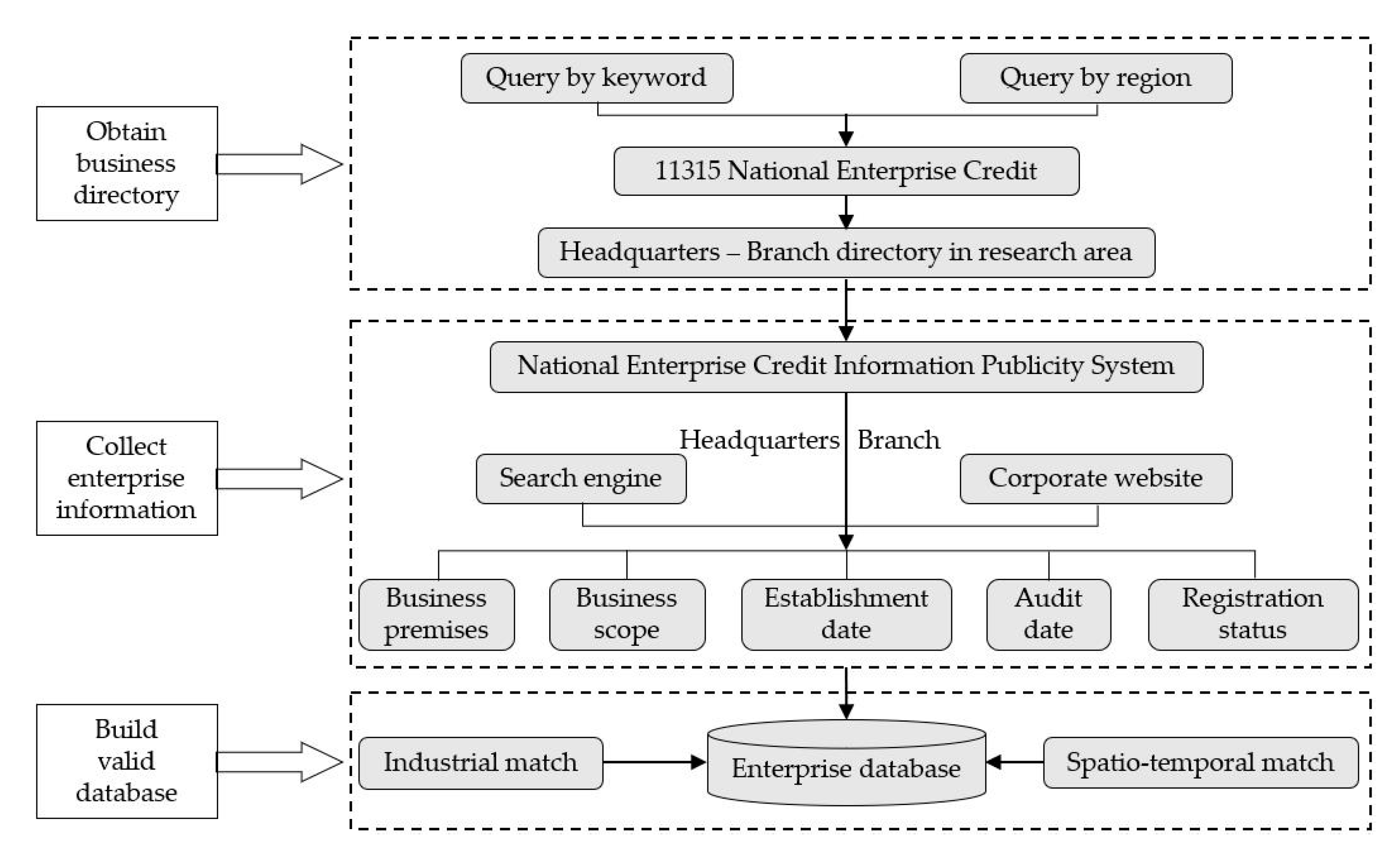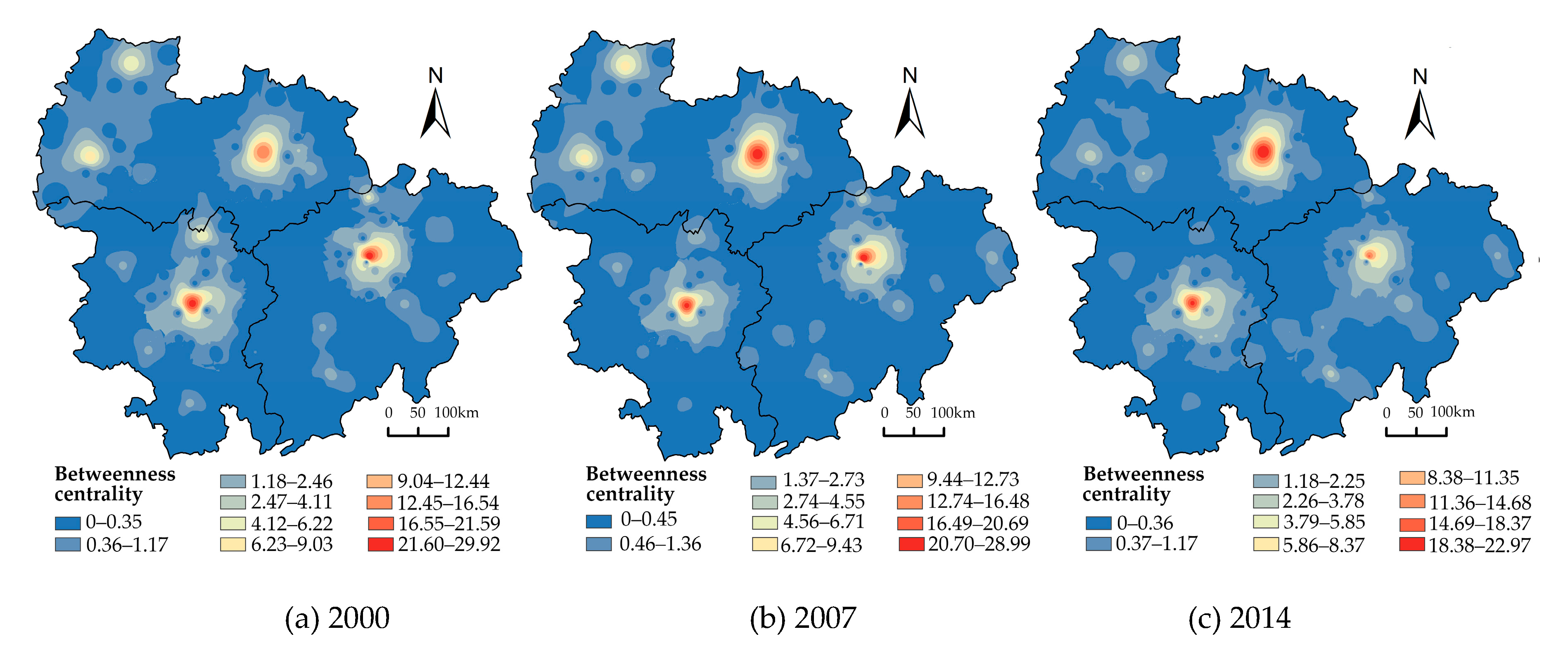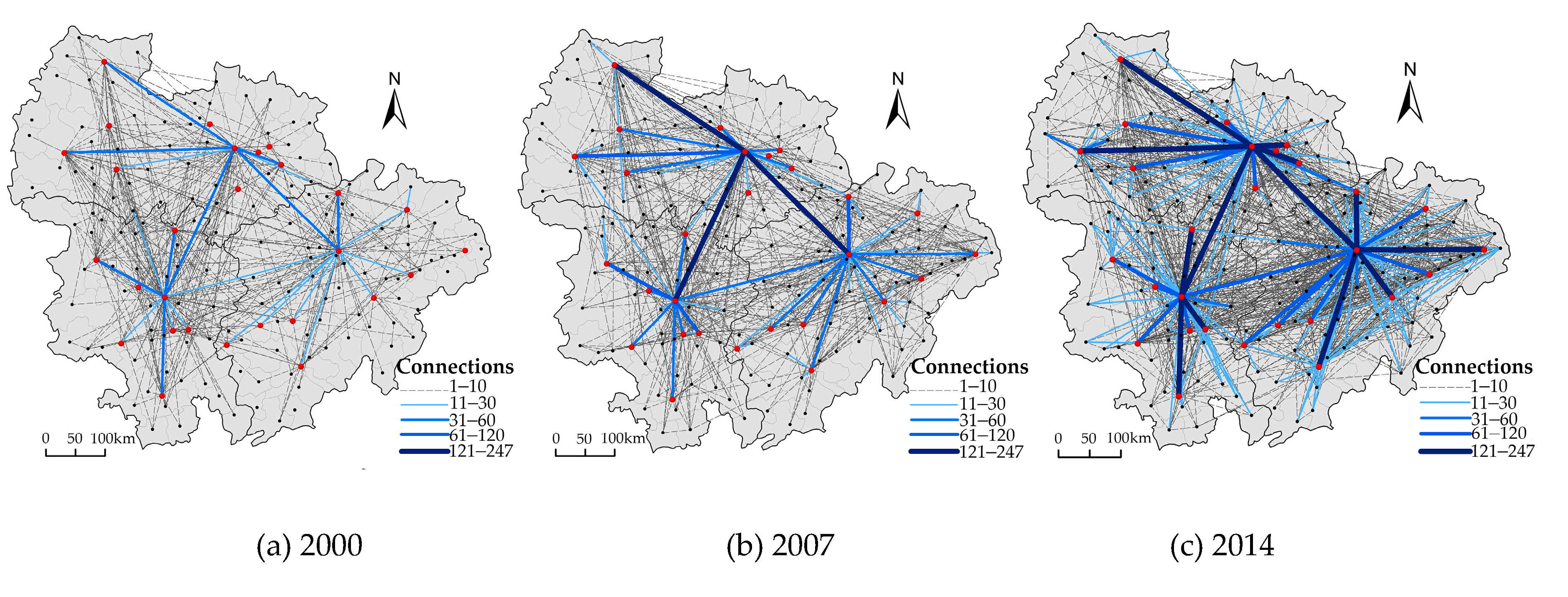Development of Economic Integration in the Central Yangtze River Megaregion from the Perspective of Urban Network Evolution
Abstract
:1. Introduction
2. Literature Review
2.1. Megaregions: The New Strategic Terrain
2.2. Integrative Process in the CYRM
3. Materials and Methods
3.1. Geographic Sampling
3.2. Data Collection
3.3. Analysis Measurement
3.3.1. Network Construction and Representation
3.3.2. Accessibility Measurement and Panel Data Model
4. Evolution of Internal Collaboration Network
4.1. Nodal Centrality Analysis
4.2. Spatial Connection Identification
4.3. Hierarchical Structure Partition
5. Transportation Influences on Integrated Networks
6. Discussion
Author Contributions
Funding
Conflicts of Interest
References
- United Nations-Habitat (UN-Habitat). State of the World’s Cities 2010/2011: Bridging the Urban Divide; Earthscan: London, UK, 2010; pp. 8–10. [Google Scholar]
- Dewar, M.; Epstein, D. Planning for “megaregions” in the United States. J. Plan. Lit. 2007, 22, 108–124. [Google Scholar] [CrossRef]
- Regional Plan Association. Northeast Megaregion 2050: A Common Future; Regional Plan Association: New York, NY, USA, 2007. [Google Scholar]
- Bunnell, T.; Goh, D.P.S.; Lai, C.K.; Pow, C.P. Introduction: Global urban frontiers? Asian cities in theory, practice and imagination. Urban Stud. 2012, 49, 2785–2793. [Google Scholar] [CrossRef]
- Li, Y.; Wu, F. Understanding city-regionalism in China: Regional cooperation in the Yangtze River Delta. Reg. Stud. 2018, 52, 313–324. [Google Scholar] [CrossRef]
- Wachsmuth, D. Megaregions and the urban question: The new strategic terrain for US urban competitiveness. In Megaregions: Globalization’s New Urban Form; Harrison, J., Hoyler, M., Eds.; Edward Elgar: Cheltenham, UK, 2015; pp. 51–74. [Google Scholar]
- Harrison, J.; Hoyler, M. Megaregions: Globalizations new urban form? Edward Elgar Pub: Cheltenham, UK, 2015. [Google Scholar]
- Ye, L. Urban transformation and institutional policies: Case study of mega-region development in China’s Pearl River Delta. J. Urban Plan. Dev. 2013, 139, 292–300. [Google Scholar] [CrossRef]
- Li, Y.; Wu, F.; Hay, I. City-region integration policies and their incongruous outcomes: The case of Shantou-Chaozhou-Jieyang city-region in east Guangdong Province, China. Habitat Int. 2015, 46, 214–222. [Google Scholar] [CrossRef]
- Taylor, P.J.; Evans, D.M.; Pain, K. Application of the interlocking network model to mega-city-regions: Measuring polycentricity within and beyond city-regions. Reg. Stud. 2008, 42, 1079–1093. [Google Scholar] [CrossRef]
- Cheng, Y.; LeGates, R. China’s hybrid global city region pathway: Evidence from the Yangtze River Delta. Cities 2018, 77, 81–91. [Google Scholar] [CrossRef]
- Alderson, A.S.; Beckfield, J.; Sprague-Jones, J. Intercity relations and globalisation: The evolution of the global urban hierarchy, 1981—2007. Urban Stud. 2010, 47, 1899–1923. [Google Scholar] [CrossRef]
- Robinson, J. Global and world cities: A view from off the map. Int. J. Urban Reg. Res. 2002, 26, 531–554. [Google Scholar] [CrossRef]
- Marull, J.; Galletto, V.; Domene, E.; Trullén, J. Emerging megaregions: A new spatial scale to explore urban sustainability. Land Use Policy 2013, 34, 353–366. [Google Scholar] [CrossRef]
- Zhang, W.; Derudder, B.; Wang, J.; Witlox, F. An analysis of the determinants of the multiplex urban networks in the Yangtze River Delta. Tijdschr. Voor Econ. En Soc. Geogr. 2019. [Google Scholar] [CrossRef]
- Brenner, N. New State Spaces: Urban Governance and the Rescaling of Statehood; Oxford University Press: Oxford, UK, 2004. [Google Scholar]
- Scott, A.; Storper, M. Regions, globalization, development. Reg. Stud. 2003, 37, 579–593. [Google Scholar] [CrossRef]
- Jonas, A.E.G.; Ward, K. Introduction to a debate on city-regions: New geographies of governance, democracy and social reproduction. Int. J. Urban Reg. Res. 2007, 31, 169–178. [Google Scholar] [CrossRef]
- Gottmann, J. Megalopolis: The Urbanized Northeastern Seaboard of the United States; Twentieth Century Fund: New York, NY, USA, 1961. [Google Scholar]
- Su, S.; Liu, Z.; Xu, Y.; Li, J.; Pi, J.; Weng, M. China’s megaregion policy: Performance evaluation framework, empirical findings and implications for spatial polycentric governance. Land Use Policy 2017, 63, 19. [Google Scholar] [CrossRef]
- Florida, R.; Gulden, T.; Mellander, C. The rise of the mega-region. Camb. J. Reg. Econ. Soc. 2008, 1, 459–476. [Google Scholar] [CrossRef]
- Ross, C.L.; Woo, M. Megaregions and mobility. Bridge 2011, 41, 24–34. [Google Scholar]
- Meijers, E. From central place to network model: Theory and evidence of a paradigm change. Tijdschr. Voor Econ. En Soc. Geogr. 2007, 98, 245–259. [Google Scholar] [CrossRef]
- Neal, Z.P. From central places to network bases: A transition in the U.S. urban hierarchy, 1900–2000. City Community 2011, 10, 49–75. [Google Scholar] [CrossRef]
- Dematteis, G. Globalisation and regional integration: The case of the Italian urban system. GeoJournal 1997, 43, 331–338. [Google Scholar] [CrossRef]
- Ortega, A.A.; Acielo, J.M.A.E.; Hermida, M.C.H. Mega-regions in the Philippines: Accounting for special economic zones and global-local dynamics. Cities 2015, 48, 130–139. [Google Scholar] [CrossRef]
- Roy, A. The 21st-century metropolis: New geographies of theory. Reg. Stud. 2009, 43, 819–830. [Google Scholar] [CrossRef]
- Friedmann, J. China’s Urban Transition; University of Minnesota Press: Minneapolis, MN, USA, 2005; pp. 111–116. [Google Scholar]
- He, J.; Zong, Y.; Gebhardt, H. New spatial strategy in China: Major function zoning of Beijing-Tianjin metropolitan area with perspective from ecological economics. J. Urban Plan. Dev. 2011, 137, 484–494. [Google Scholar] [CrossRef]
- Kiggundu, M.N.; Deghetto, K. Regional integration: Review of the management literature and implications for theory, policy, and practice. Afr. J. Manag. 2015, 1, 303–332. [Google Scholar] [CrossRef]
- Paluzie, E.; Pons, J.; Tirado, D.A. Regional integration and specialization patterns in Spain. Reg. Stud. 2001, 35, 285–296. [Google Scholar] [CrossRef]
- Chung, H. Unequal regionalism: Regional planning in China and England. Plann. Pract. Res. 2015, 30, 570–586. [Google Scholar] [CrossRef]
- Duan, D.; Zhang, Y.; Chen, Y.; Du, D. Regional integration in the inter-city technology transfer system of the Yangtze River Delta, China. Sustainability 2019, 11, 2941. [Google Scholar] [CrossRef]
- Li, Y.; Wu, F. The transformation of regional governance in China: The rescaling of statehood. Prog. Plan. 2012, 78, 55–99. [Google Scholar] [CrossRef]
- Augustin-Jean, L. Urban planning in Hong Kong and integration with the Pearl River Delta: A historical account of local development. GeoJournal 2005, 62, 1–13. [Google Scholar] [CrossRef]
- Oizumi, K. The emergence of the Pearl River Delta Economic Zone—Challenges on the path to megaregion status and sustainable growth. Pac. Bus. Ind. 2011, 11, 2–20. [Google Scholar]
- Wang, L. High-speed rail services development and regional accessibility restructuring in megaregions: A case of the Yangtze River Delta, China. Transp. Policy 2018, 72, 34–44. [Google Scholar] [CrossRef]
- Yu, W.; Zhou, W. Spatial pattern of urban change in two Chinese megaregions: Contrasting responses to national policy and economic mode. Sci. Total Environ. 2018, 634, 1362–1371. [Google Scholar] [CrossRef] [PubMed]
- Wang, L.; Yang, W.; Yuan, Y.; Liu, C. Interurban consumption flows of urban agglomeration in the middle reaches of the Yangtze River: A network approach. Sustainability 2019, 11, 268. [Google Scholar] [CrossRef]
- Yu, Y.; Han, Q.; Tang, W.; Yuan, Y.; Tong, Y. Exploration of the industrial spatial linkages in urban agglomerations: A case of urban agglomeration in the middle reaches of the Yangtze River, China. Sustainability 2018, 10, 1469. [Google Scholar] [CrossRef]
- 11315 National Enterprise Credit System Home Page. Available online: https://admin.11315.com (accessed on 26 November 2015).
- National Enterprise Credit Evaluation Information Publicity System Home Page. Available online: https://www.zhengxinju.org.cn (accessed on 26 November 2015).
- Sun, Q.; Tang, F.; Tang, Y. An economic tie network-structure analysis of urban agglomeration in the middle reaches of Changjiang River based on SNA. J. Geogr. Sci. 2015, 25, 739–755. [Google Scholar] [CrossRef] [Green Version]
- Borgatti, S.P.; Everett, M.G. Models of core/periphery structures. Soc. Netw. 2000, 21, 375–395. [Google Scholar] [CrossRef]
- Zhang, X.; Guo, Q.E.; Cheung, D.M.W.; Zhang, T. Evaluating the institutional performance of the Pearl River Delta integration policy through intercity cooperation network analysis. Cities 2018, 81, 131–144. [Google Scholar] [CrossRef]
- Anas, A.; Arnott, R.; Small, K.A. Urban spatial structure. J. Econ. Lit. 1998, 36, 1426–1464. [Google Scholar]
- Fuglsang, M.; Hansen, H.S.; Münier, B. Accessibility analysis and modelling in public transport networks—A raster based approach. In Proceedings of the International Conference on Computational Science and Its Applications, Santander, Spain, 20–23 June 2011; Springer: Berlin/Heidelberg, Germany, 2011; pp. 207–224. [Google Scholar]
- Bono, F.; Gutiérrez, E. A network-based analysis of the impact of structural damage on urban accessibility following a disaster: The case of the seismically damaged Port Au Prince and Carrefour urban road networks. J. Transp. Geogr. 2011, 19, 1443–1455. [Google Scholar] [CrossRef]
- He, D.; Sun, Z.; Gao, P.; Lau, Y.Y. Spatial–temporal evolution of the port–hinterland relationship: A case study of the Midstream Yangtze River, China. Growth Chang. 2019. [Google Scholar] [CrossRef]
- Hausman, J.A. Specification tests in econometrics. Econometrica 1978, 46, 1251–1271. [Google Scholar] [CrossRef]
- Tang, F.H.; Tang, H.; Sun, Q.; Tang, D. Analysis of the economic network structure of urban agglomerations in the middle Yangtze River. Acta. Geogr. Sin. 2013, 68, 1357–1366. (In Chinese) [Google Scholar]
- Junde, L. Perspective of the ‘administrative region economy’ phenomenon in China’s transitional period—An introduction of human-economic geography with Chinese characteristic. Econ. Geogr. 2006, 26, 897–901. (In Chinese) [Google Scholar]
- Hanssens, H.; Derudder, B.; Van Aelst, S.; Witlox, F. Assessing the functional polycentricity of the mega-city-region of central Belgium based on advanced producer service transaction links. Reg. Stud. 2014, 48, 1939–1953. [Google Scholar] [CrossRef]
- Lee, P.K. Local economic protectionism in China’s economic reform. Dev. Policy Rev. 1998, 16, 281–303. [Google Scholar] [CrossRef]
- Batisse, C.; Poncet, S. Protectionism and industry location in Chinese provinces. J Chin. Econ. Bus. Stud. 2004, 2, 133–154. [Google Scholar] [CrossRef]
- Rivera, M.T.; Soderstrom, S.B.; Uzzi, B. Dynamics of dyads in social networks: Assortative, relational, and proximity mechanisms. Annu. Rev. Sociol. 2010, 36, 91–115. [Google Scholar] [CrossRef]
- Andrew, S.A. Regional integration through contracting networks. Urban Aff. Rev. 2009, 44, 378–402. [Google Scholar] [CrossRef]
- He, D.; Yin, Q.; Zheng, M.; Gao, P. Transport and regional economic integration: Evidence from the Chang-Zhu-Tan region in China. Transp. Policy 2019, 79, 193–203. [Google Scholar] [CrossRef]
- He, D.; Gao, P.; Sun, Z.; Lau, Y.Y. Measuring water transport efficiency in the Yangtze River economic Zone, China. Sustainability 2017, 9, 2278. [Google Scholar] [CrossRef]
- Lãœthi, S.; Thierstein, A.; Goebel, V. Intra- firm and extra-firm linkages in the knowledge economy: The case of the emerging mega-city region of Munich. Glob. Netw. 2010, 10, 114–137. [Google Scholar] [CrossRef]
- Yeh, A.G.O.; Yang, F.F.; Wang, J. Producer service linkages and city connectivity in the mega-city region of China: A case study of the Pearl River Delta. Urban Stud. 2015, 52, 2458–2482. [Google Scholar] [CrossRef]









| Variable | Equation | Meaning |
|---|---|---|
| Degree centrality/out-degree centrality/in-degree centrality | where represents out-degree centrality or in-degree centrality of city i in the directed network while it indicates degree centrality in the undirected network. represents the directed connection value of city i and city j in the directed network, and it represents the undirected connection value of city i and city j in the undirected network; k is the number of nodes. | It represents the central position of a single city in an urban network; specifically, out-degree centrality indicates a city’s radiation capacity in a directed network whereas in-degree centrality indicates a city’s absorptive capacity in a directed network. |
| Betweenness centrality | denotes betweenness centrality of city i, is the number of the shortest paths that pass through city i between j and k. | It indicates a strong brokering role, that is, controlling connections with others. |
| Connection intensity | represents the connection intensity of city i, and is the total number of headquarters–branch linkages between city i and j. | In contrast to degree centrality, it can be used to explicitly describe the spatial evolution of intercity connections. |
| Network density | where D is network density, indicates the directed connection is the number of existing connections, and n is the number of nodes in the network. | It measures the degree of linkages among nodes. The value of D should be between zero and one. When D = 0, there is no contact among nodes and all nodes are isolated from each other. When D = 1, all nodes are directly connected to all other nodes in the network. |
| Transportation Mode | Maximum Design Speed (km/h) | Grid Crossing Time (Minutes/0.3 km) |
|---|---|---|
| High-speed railway | 300 | 0.06 |
| Railway | 90 | 0.20 |
| Expressway | 120 | 0.15 |
| National highway | 80 | 0.23 |
| Provincial highway | 60 | 0.30 |
| County road | 40 | 0.45 |
| Land | 20 | 0.90 |
| Lake | 1 | 18.00 |
| Main stream of Yangtze River | 25 | 0.72 |
| Tributary stream of Yangtze River | 20 | 0.90 |
| Explanatory Variables | Model 1 | Model 2 | Model 3 |
|---|---|---|---|
| Constant | 4.76670 *** (5.620) | 4.45997 *** (9.202) | 6.75049 *** (26.088) |
| Acc | −1.96248 *** (−5.830) | −1.699246 *** (−5.166) | −1.64511 *** (−15.528) |
| PGDP | 0.00049 ** (3.442) | 0.00018 (2.198) | 0.00013 ** (2.957) |
| PRSCG | 0.00001 (0.273) | 0.00006 ** (2.666) | 0.00009 *** (9.691) |
| PFAI | 0.00067 (9.883) | 0.00027 *** (6.246) | 0.00017 *** (8.683) |
| Adjusted R2 | 0.532 | 0.531 | 0.966 |
| F-value | 84.102 *** | 83.690 *** | 83.934 *** |
| LR test | 23.454 *** | ||
| Hausman test | 170.545 *** | ||
| Number of observations | 534 | 534 | 534 |
© 2019 by the authors. Licensee MDPI, Basel, Switzerland. This article is an open access article distributed under the terms and conditions of the Creative Commons Attribution (CC BY) license (http://creativecommons.org/licenses/by/4.0/).
Share and Cite
He, D.; Sun, Z.; Gao, P. Development of Economic Integration in the Central Yangtze River Megaregion from the Perspective of Urban Network Evolution. Sustainability 2019, 11, 5401. https://doi.org/10.3390/su11195401
He D, Sun Z, Gao P. Development of Economic Integration in the Central Yangtze River Megaregion from the Perspective of Urban Network Evolution. Sustainability. 2019; 11(19):5401. https://doi.org/10.3390/su11195401
Chicago/Turabian StyleHe, Dan, Zhijing Sun, and Peng Gao. 2019. "Development of Economic Integration in the Central Yangtze River Megaregion from the Perspective of Urban Network Evolution" Sustainability 11, no. 19: 5401. https://doi.org/10.3390/su11195401





